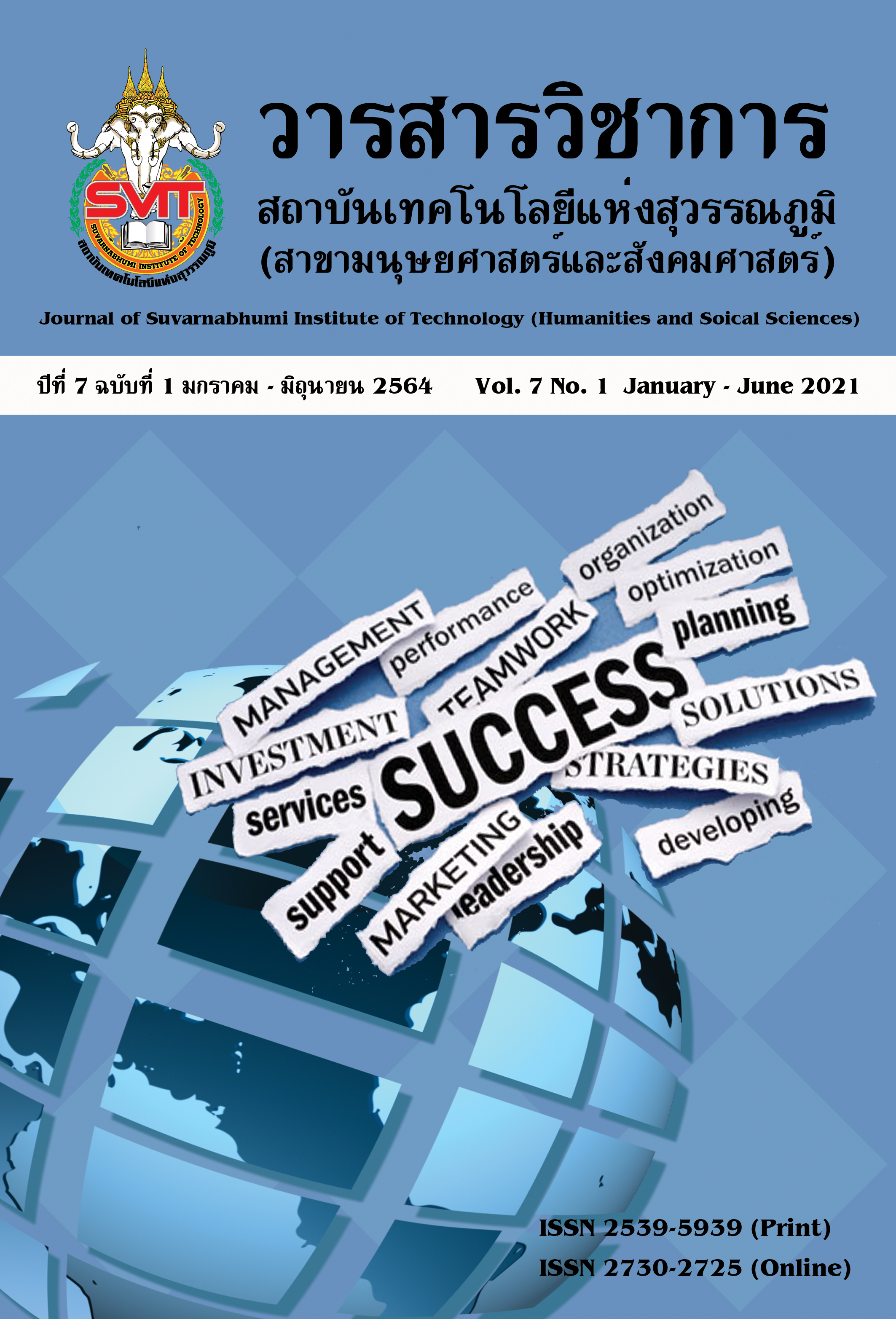THE STUDY OF FACTORS INFLUENCING ORGANIZATIONAL INNOVATIVENESS OF SMEs OF SERVICE SECTOR IN BANGKOK
Keywords:
Organizational Innovation, Small and Medium Enterprises (SMEs) Of Service BusinessAbstract
This research uses a mixed methodology with the objectives:
- to study the innovative conditions within organizations using Qualitative Research method and relying on the Interview Forms to gathering data from high level executives representing 20 organizations
- to study factors which influence organizational innovativeness using Quantitative Research and relying on Questionnaires to gather data from administrators, personnel, and people performing duties in 400 organizations. Quantitative Data Analysis is performed using software package program. Statistics used are frequency table, percentage, minimum value, maximum value, arithmetic mean, standard deviation, skewness value, kurtosis value, and confirmatory factor analysis techniques and structural equation model on the Partial Least Squares Path Modeling (PLS Path Modeling).
Results of the study are as follows: (1) most organizations do not have innovation; just only a working process in a specific area for the quality to respond to the market needs and bringing the system or technology to help increase the operational efficiency. Organizations are aware of the benefits and importance of innovation, but, there are limitations and obstacles such as financial barriers, lack of government supports, etc. and (2) Factors influencing innovation within the organizations being developed in the form of causal relation are as follows: The human resource management factors have indirect relation with the innovation within the organizations through the organizational management (IE = 0.060 *). The organizational management factors have direct relation with the innovation within the organizations (DE = 0.359 *). The leadership status factors have direct and indirect relation with the innovation within the organizations through the organizational management (TE = 0.141 *; DE = 0.097 * + IE = 0.044 *). The organizational vision and strategic factors have direct and indirect relation with the innovation within the organizations through the organizational leadership and management (TE = 0.396 *; DE = 0.229 *+IE = 0.167 *) and knowledge management factors have direct and indirect relation with the innovation within the organizations through human resource management, organizational management (TE = 0.281 *; DE = 0.101 * + IE = 0.180 *) (P <0.05) and the causal relation model of factors that influence the organizational innovation of Small and Medium Enterprises (SMEs) in the service business in Bangkok Metropolitan areas which have been developed have the virtually convergent validity, good predictability and acceptability calculated to be forty-nine point six percent (49.6%).
References
กัญจน์กาจ ยิ่งชล. (2559). นวัตกรรมของอุตสาหกรรมยานยนต์ในระดับ SMEs. กรุงเทพฯ: มหาวิทยาลัย ธรรมศาสตร์.
กีรติ ยศยิ่งยง. (2552). องค์กรแห่งนวัตกรรม แนวคิด และกระบวนการ. กรุงเทพฯ: โรงพิมพ์แห่งจุฬาลงกรณ์มหาวิทยาลัย
คฑาวุฒิ สังฆมาศ, และคณะ. (2560). นวัตกรรมสร้างสรรค์ทางธุรกิจเพื่อการส่งออกกับนโยบายไทยแลนด์ 4.0. วารสารบัณฑิตศาส์น, 15(2), 124-131.
ชัชพล ทรงสุนทรวงศ์. (2559). นวัตกรรมการบริการ: กลยุทธ์ที่สร้างความได้เปรียบทางการแข่งขันขององค์การธุรกิจบริการ. วารสารการจัดการสมัยใหม่, 14(2), 13-24.
ณัฐวัฒน์ สุขะศิริวัฒน์, และคณะ. (2557). ความท้าทายและข้อจำกัดของการขับเคลื่อนนวัตกรรม สำหรับธุรกิจขนาดกลางและขนาดย่อมในประเทศไทย. วารสารวิจัยและพัฒนา มจธ, 37(1), 119-131.
วุฒิพงษ์ ภักดีเหลา. (2554). การศึกษาคุณลักษณะขององค์การนวัตกรรมกรณีศึกษาองค์การที่ได้รับรางวัลด้านนวัตกรรม. กรุงเทพฯ: สถาบันบัณฑิตพัฒนบริหารศาสตร์.
อรวรางค์ จันทร์เกษม, และคณะ. (2558). ความสัมพันธ์ระหว่างปัจจัยส่วนบุคคล ภาวะผู้นำเชิงนวัตกรรมของผู้บริหารตามความคิดเห็นของพนักงานและพฤติกรรมมุ่งผลสัมฤทธิ์ในการทำงานของพนักงงานในอุตสาหกรรมการผลิต. วารสารวิชาการศิลปะศาสตร์ประยุกต์, มกราคม-มิถุนายน, 138-144.
Diamantopoulos, A. & Siguaw, J. A., (2000). Introduction to LISREL: A guide for the uninitiated. London: SAGE Publications, Inc,.
Joreskog, K. G., and Sorbom, D. (1993). LISREL 8: Structural equation modeling with the SIMPLIS command language. Scientific Software International.
Winter, S. G. (2003). Understanding dynamic capabilities. Strategic Management Journal, 24(10), 991-995.
Saris, W. E., & Stronkhorst. (1984). Casual modeling in No experimental Research: an introduction to the Lisrel Approach. Dissertation Abstract International, 47(7), 2261-A.
Downloads
Published
Issue
Section
License
บทความที่ได้รับการตีพิมพ์เป็นลิขสิทธิ์ของวารสารวิชาการ สถาบันเทคโนโลยีแห่งสุวรรณภูมิ
ข้อความที่ปรากฏในบทความแต่ละเรื่องในวารสารวิชาการเล่มนี้เป็นความคิดเห็นส่วนตัวของผู้เขียนแต่ละท่านไม่เกี่ยวข้องกับสถาบันเทคโนโลยีแห่งสุวรรณภูมิ และคณาจารย์ท่านอื่นๆในสถาบันฯ แต่อย่างใด ความรับผิดชอบองค์ประกอบทั้งหมดของบทความแต่ละเรื่องเป็นของผู้เขียนแต่ละท่าน หากมีความผิดพลาดใดๆ ผู้เขียนแต่ละท่านจะรับผิดชอบบทความของตนเองแต่ผู้เดียว





